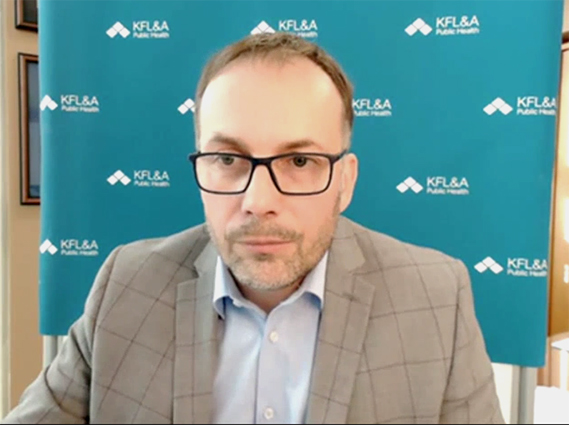Adam Prudhomme
Editor
Social gatherings are among the factors being blamed for the recent spike in COVID-19 cases across the KFLA region.
Speaking with local media via Skype on Wednesday, KFLA Public Health medical officer of health Dr. Piotr Oglaza covered that topic along with the Omicron variant as well as whether any additional measures would be put in place.
His update came as the region again set a new high for daily case count, pushing up to 304 with 34 new cases.
“Unfortunately in KFLA region we continue to see a rise in local case counts,” said Oglaza. “Our COVID activity over the past few weeks is unfortunately consistent with the progression of the fourth wave of COVID-19. What’s driving a lot of this spread is the fact that there’s still thousands of individuals in our community who are not yet fully vaccinated. That includes those not yet eligible, those recently eligible, so children (aged) 5 to 11, but also many eligible adults who did not take the opportunity to get vaccinated. Not having that layer of protection and also having not been exposed to COVID-19 throughout the course of the previous waves makes the unvaccinated people more susceptible to infection right now during the peak of the cold and flu season where respiratory viruses are spreading more readily.”
“Where we see transmission locally is not linked to any particular type of setting or sector, although household transmission remains to be the highest setting for spread,” Oglaza added. “It’s related to the types of activity such as social interaction with a lot of mixing and mingling. If you think of a typical scenario of a holiday office party, or house party where people would be mixing, mingling, standing, chatting, that’s really the prime setting for COVID transmission and sadly this is where we see a lot of our spread is attributed to.”
Oglaza reiterated the importance of getting vaccinated, particularly as the calendar flipped to December.
“It’s really important that moving into the holiday season, getting vaccinated remains our key measure and priority,” said Oglaza. “This is not only going to protect individuals, families, loved ones, but also play a role in protecting the community as a whole. Those who are not yet eligible to be vaccinated, those who are older and might have underlying health conditions, they rely on everyone else doing their part in getting immunized, reducing the transmission in the community to prevent and protect those vulnerable individuals from getting infected and then being at higher risk of hospitalization with COVID.”
One area the KFLA region is doing well is testing. Oglaza noted about three per cent of the population is getting tested a week with a per cent positivity of about 2.51. Though the cases are still much higher than he’d like, the per cent positivity number is a good one, all things considered.
“What’s also happening is many individuals may not recognize that their symptoms that they may attribute to be a mild cold, could in fact be COVID,” said Oglaza. “That really reinforces the message of doing daily screening and staying home when sick and seeking testing. I want to take a moment to thank of community for hearing that message about testing really well. I know that we already recently already had some feedback that there might be less availability for testing appointments, but that capacity has been increased through work with our partners at KHSC assessment centres and the availability is there to match that demand. What we see locally in KFLA region compared to other health units with also higher case counts, we have one of the best indicators in terms of per cent positivity. What that means is that a sufficient number of people are getting tested.”
Oglaza said in particular they are seeing a high testing rate among children, which is allowing the health unit to detect positive cases and intervening before they spread within a classroom.
“Our key message remains to get vaccinated,” he added. “We see vaccine provides a tremendous protection for individuals for people who are fully immunized and significantly reduces the risk of first of all getting COVID but then also getting sick from COVID to a point that requires hospitalization or ICU admission or sadly, dying.”
When asked about the Omicron variant, Oglaza said the strain is already in Canada.
“We know it is the real possibility and it’s not a matter of if it’s unfortunately a matter of when we might see Omicron cases in other parts of the province,” he said. “What the current strategy is for Omicron is one of containment. There’s going to be additional measures in terms of screening of travellers, in terms of testing that looks for the potential of Omicron being the pathogen in an individual who is diagnosed with COVID-19. For those individuals and those contacts of individuals there might be additional management in terms of case contact management that are more strict compared to the regular COVID-19 case management.”
Those measures are important as more studies are conducted on the latest variant. Scientists are aiming to learn just how resistant the latest mutation will be to the vaccine and just how severe an infection it can cause.
Oglaza also noted he is in daily contact with the province to discuss any additional measures that could be put into effect to help curtail the spread of the virus. Last week he issued a special Section 22 Order that limited the number of household gatherings to 10 people.
He said he couldn’t go into detail as to what those additional measures might be but added they would be aimed at changing habits, such as gatherings in which no public health measures are in place.

